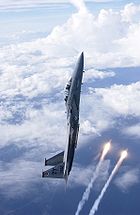
Rate of climb
Encyclopedia

Aeronautics
Aeronautics is the science involved with the study, design, and manufacturing of airflight-capable machines, or the techniques of operating aircraft and rocketry within the atmosphere...
, the rate of climb (RoC) is an aircraft's vertical speed - the rate of change in altitude
Altitude
Altitude or height is defined based on the context in which it is used . As a general definition, altitude is a distance measurement, usually in the vertical or "up" direction, between a reference datum and a point or object. The reference datum also often varies according to the context...
. In most ICAO member countries (even in otherwise metric countries), this is usually expressed in feet per minute
Minute
A minute is a unit of measurement of time or of angle. The minute is a unit of time equal to 1/60th of an hour or 60 seconds. In the UTC time scale, a minute on rare occasions has 59 or 61 seconds; see leap second. The minute is not an SI unit; however, it is accepted for use with SI units...
and can be abbreviated as ft/min. Elsewhere, it is commonly expressed in metres per second
Second
The second is a unit of measurement of time, and is the International System of Units base unit of time. It may be measured using a clock....
, abbreviated as m/s. The rate of climb in an aircraft is indicated with a vertical speed indicator (VSI) or instantaneous vertical speed indicator (IVSI).
The rate of decrease in altitude is referred to as the rate of descent or sink rate. A decrease in altitude corresponds with a negative rate of climb.
There are a number of designated airspeeds
V speeds
In aviation, V-speeds are standard terms used to define airspeeds important or useful to the operation of all aircraft including fixed-wing aircraft, gliders, autogiros, helicopters, and dirigibles...
relating to optimum rates of ascent, the two most important of these are Vx and Vy.
Vx is the indicated airspeed for best angle of climb
Angle of Climb
In aerodynamics, angle of climb is the ratio between distance travelled over the ground and altitude gained. The angle of climb can be expressed as the angle between a plane horizontal to the Earth's surface and the actual flight path followed by the aircraft during its ascent...
. Vy is the indicated airspeed for best rate of climb. Vx is slower than Vy.
Climbing at Vx allows pilots to maximize the altitude gain per unit ground distance. That is, Vx allows pilots to maximize their climb while sacrificing the least amount of ground distance. This occurs at the speed for which the difference between thrust and drag is the greatest (maximum excess thrust). In a jet airplane, this is approximately minimum drag speed, or the bottom of the drag vs. speed curve.
Climbing at Vy allows pilots to maximize the altitude gain per unit time. That is, Vy, allows pilots to maximize their climb while sacrificing the least amount of time. This occurs at the speed for which the difference between engine power and the power required to overcome the aircraft's drag is the greatest (maximum excess power). Climb rate is proportional to excess power.
Vx increases with altitude and Vy decreases with altitude. Vx = Vy at the airplane's absolute ceiling, the altitude above which it cannot climb using just its own lift.
The initial rate of climb record for pilot aircraft is held by MiG-29 at 330 m/s (65,000 ft/min). The average rate of climb for a MiG-29 is 109 m/s from sea level to 6000 m.

